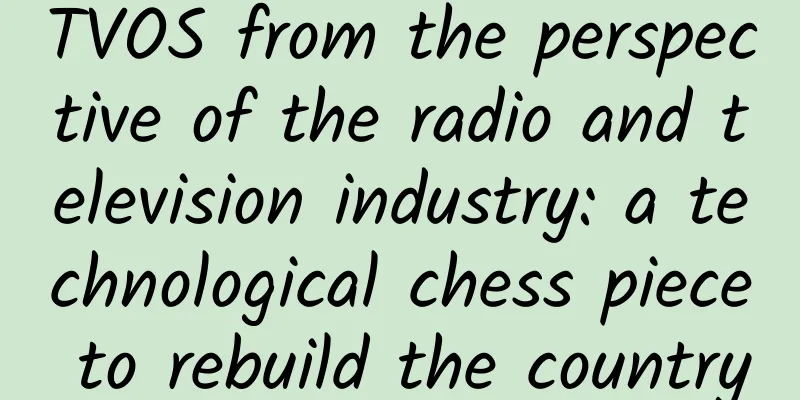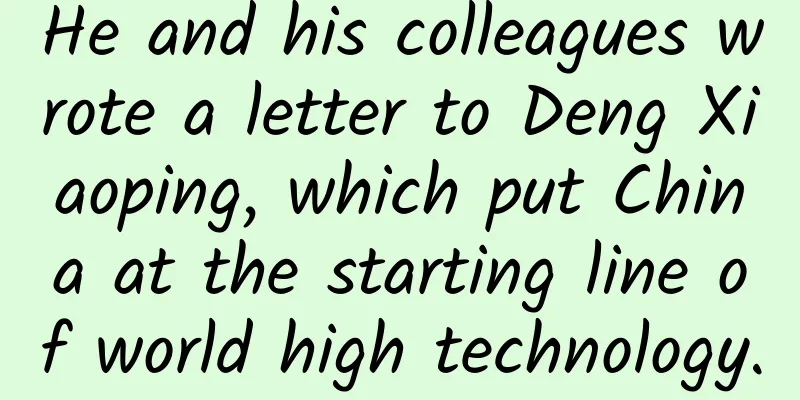TVOS from the perspective of the radio and television industry: a technological chess piece to rebuild the country

|
TVOS1.0 is a technical move by the State Administration of Press, Publication, Radio, Film and Television to integrate the radio and television systems. The so-called State Grid Corporation, which was finally born after many difficult births, is a move in organizational structure. The birth of TVOS1.0 is related to the previous IPTV and OTT. The latter two, except for the content link which is still dominated by radio and television, are mainly the territory of telecommunications. TVOS1.0 can be said to be a technical tool for radio and television to protect the last core territory - cable TV. At the same time, it is also a step to reorganize and counterattack IPTV and OTT. Cable TV is indeed a high-quality asset of the radio and television system. Whether it is policy and technology, content and application, users and market, or business model, it is relatively mature. There are also many good companies in various places, and many of them have already been listed. However, this business has been facing the penetration and disintegration of telecom. In the past few years, the impact of IPTV and OTT has had a great impact on its confidence. In various broadcasting and television forums in the past two years, cable TV operators are really facing many crises. Let me talk about it a little bit more in a roundabout way. IPTV was originally seen as a knife stuck in the heart of the telecommunications industry by the telecommunications industry, and it was true. The concept of OTT did not exist at the time, and in terms of business model, the radio and television industry was dominated by telecommunications OTT. The core operation and billing systems of IPTV were mainly in the hands of telecommunications, and they penetrated from the study to the bedroom and living room, and were once invincible. In the past two years, IPTV once developed "disorderly". The radio and television industry became anxious when they saw that the companies within their system were so deeply tied to telecommunications. They kept making noises, and finally, unable to handle it any longer, they integrated its IPTV with that of CCTV (CNTV) at the expense of the interests of the listed company BesTV. But the integration effect is a double-edged sword. It blocks telecommunications, inhibits the development of IPTV, and provides room for the OTT model to grow. OTT, in theory, is something that the radio and television department originally had. The General Administration issued several broadcast control licenses that year. If the operation was fully regulated, it could play a core role in the industry chain. However, OTT is grafted onto telecommunications broadband infrastructure. Although radio and television can OTT telecommunications, they cannot truly control the terminals. In order to expand the market, the license holders are more willing to leverage open Internet companies. Telecom is eager for them to be together, which leads to many problems in content and information. Radio and television are anxious, but their subsequent supervision is only formalistic and not only ineffective, but also often arouses public opinion. If this continues, problems will arise sooner or later. This means that in the short term, based on the telecommunications broadband path, it is impossible for radio and television to truly be manageable and controllable in the field of television. The infrastructure is the pipeline, and the business model is dominated by others. How can you make delicious dishes that suit your taste at their place? Of course, the real problem is not the poor business and management, but the complicated and fragmented radio and television system caused by China's system. Up to now, China still continues the "four-level management" construction policy of radio, television, and mixed coverage for decades, and has not really changed the serious regional and block fragmentation of the radio and television system. The radio and television system is complicated, central and local, the same industry and different industries, and almost no field can form an independent operation feature of the whole country. This is in stark contrast to the vertical system of telecom operators from the central government to local governments. Under this structure, local radio and television companies and businesses can easily seek their own independent solutions, especially by cooperating with telecom operators, which have been defeated one by one. Radio and Television has been seeking to become the core operator of the future three-network integration. Compared with telecommunications, although it has weaker financial strength and is subject to many policy repressions, the mutual penetration between it and telecommunications, which is restrained in form, has in fact become a one-way penetration of telecommunications. The one-way penetration of telecommunications seems to be flourishing everywhere, in line with market trends and attracting good consumers, but it has accumulated many problems, especially in standards, operations, content, applications and services. There is chaos, resulting in a lot of disorder, each occupying its own territory, duplicate construction, serious market segmentation, lack of synergy in the industry, and limited overall scale. From the perspective of radio and television, it has to bear a lot of social responsibilities for this. Most of the criticisms of radio and television focus on anti-market supervision, but they fail to see that many of its responsibilities focus on spirit and culture, the so-called ideological functions, which are different from the roles of telecom operators and even the Ministry of Industry and Information Technology, and cannot be completely market-oriented. Several telecom operators are listed companies and can operate as a whole country, which makes them much more open than radio and television, and easier to win public support. Radio and television have to bear more non-market responsibilities, and it is not fair to criticize radio and television as an obstacle to the integration of the three networks. This is due to the national conditions of a country. I have gone too far, so let's get back to the topic. Even in this passive situation, radio and television itself has been transforming towards marketization. In fact, NGB and OTT were initiated by radio and television. Radio and television are also guided by an open market that can be managed and controlled. When IPTV and OTT penetrated too much, radio and television also fought back. In addition to policy supervision, such as the topic of the so-called OTT box a few days ago, radio and television are actually taking the initiative through the reorganization of cable TV. In other words, radio and television will embrace models such as IPTV and OTT, but it is beginning to expect the cable model to become the core and dominant of several paths. This requires radio and television to reform in terms of policies, systems, technology, funding, assets, operations, etc., reorganize the industrial chain, and establish an ecological model. This was also the original intention of the State Grid. However, since this is a complex project, it is impossible to complete it in one step, and it is even impossible to achieve a national chess game. However, as long as the radio and television can be managed and controlled at the core level, it is also its idea to adapt to the market. Therefore, it adopts a phased approach, starting with the easy and then the difficult. We can see that the State Grid is not as domineering as originally envisioned. But this is a rational and practical step, and the radio and television system has formally become a national enterprise operating in a market-oriented manner. Integration at the technical level is more convenient than integration in other aspects. Last May, at the China Radio and Television Development Forum (Shanghai), Qin Gonglong, former director of the Cable Research Institute of the State Administration of Radio, Film and Television, said that it is most practical to first realize the integration of the radio and television system from a technical perspective, and the cable market is relatively mature and can become the main support for the integration of the three networks. In fact, the Radio and Television Planning Institute has a large number of technologies and standards in the cable field, and many have begun to apply for international standards. On this basis, an operation support and integrated network management system are formed, and finally a good "cloud-pipe-end" system is realized. Therefore, the topic of TVOS1.0 of China Media Group has been criticized by the outside world as a monopoly, but I believe that this is a key step for China Media Group to integrate cable TV business from a technical level after the establishment of State Grid Corporation, and it is also a move by the State Administration of Radio, Film and Television to promote specific business. If unified standards cannot be achieved at the technical level, the subsequent system is unlikely to be truly formed. Of course, I believe that the actions of the radio and television system will never stop at the technical level. My judgment is that in the future, the integration of cable TV operators will also occur. The practical path is to start from the province and then expand to cross-regional integration. In fact, in the past two years, sporadic occurrences have begun, but the effect is limited. Putting aside the institutional constraints of radio and television, my view is that without a strong radio and television industry, China cannot truly achieve the integration of the three networks, nor can it have a communications and media giant that surpasses overseas markets. If telecom operators only act as bystanders in this process and enjoy the penetration opportunities brought by policy changes, then they may really be replaced by OTT in the future. The reasonable situation is that the radio and television system and the telecommunications system should follow the trend, open their minds, and jointly solve problems for each other. This of course requires instructions at a higher level. As a winner of Toutiao's Qingyun Plan and Baijiahao's Bai+ Plan, the 2019 Baidu Digital Author of the Year, the Baijiahao's Most Popular Author in the Technology Field, the 2019 Sogou Technology and Culture Author, and the 2021 Baijiahao Quarterly Influential Creator, he has won many awards, including the 2013 Sohu Best Industry Media Person, the 2015 China New Media Entrepreneurship Competition Beijing Third Place, the 2015 Guangmang Experience Award, the 2015 China New Media Entrepreneurship Competition Finals Third Place, and the 2018 Baidu Dynamic Annual Powerful Celebrity. |
>>: Internet TV: Industry observations after interviewing license holders
Recommend
An Luqin: MADE Industry Research and Price Index Trend Analysis in November 2022
The MADE Industry Research Price Index is publish...
A collection of posters for small brands taking advantage of the New Year! Are you convinced?
The twenty-third day of the twelfth lunar month T...
In-depth review: Pinduoduo’s addictive model!
The author of this article personally experienced...
Android custom controls: QQ-like unread message drag effect
QQ's unread messages are a fun effect. Taking...
Tencent Advertising Strategy for Weight Loss Industry
This article focuses on six sections: "Link ...
China Automobile Dealers Association: my country's automobile dealer inventory warning index in May 2020
As the domestic anti-epidemic situation gradually...
Cancer is caused by "saving"! Doctors reveal the truth! This bad habit must be changed
Experts in this article: Hu Houxiang, Chief Physi...
Samsung monopolizes Snapdragon 835, LG G6 is forced to polish 821 processor
It has been rumored for a long time that Samsung ...
A study of more than 30,000 people shows that one can of beer a day is enough to make your brain smaller!
Alcohol consumption is one of the leading causes ...
Tesla Supercharger stations are no longer free, and will become paid
Recently, Tesla announced an adjustment to the op...
Can eye protection lamps prevent myopia?
"Doctor, is the eye protection lamp useful? ...
As long as there is light, you can surf the Internet! What is Li-Fi, which is said to be better than Wi-Fi?
Even if you have never heard of Li-Fi, you now kno...
You know that “Guilin’s landscapes are the best in the world”, but have you ever thought that Guilin is everywhere in Guangxi!
The richness of Guangxi More than you think You m...
9 examples of obtaining seed users
I often joke with my friends: Young people, don’t...
How is matter made? Can matter be divided infinitely?
If you cut a piece of matter in half, it becomes ...









